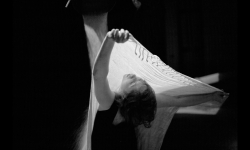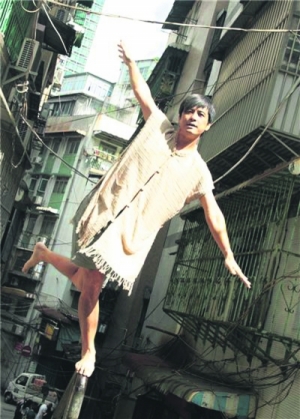 |
2015年11月
Beyond comparisons
By definition, by any definition, theatre is an experience of otherness. Regardless of how it is understood and classified sociologically, the act of watching theatre implies a spontaneous dialogue with otherness shaped by the specificity of the event. To watch a living work of art is to engage with the human beings performing it and, therefore, to acknowledge their existence for a limited period of time in a shared space. This form of implicit witnessing is nevertheless too often perceived as a passive consequence of being there rather than as a participatory dimension of the relationship between the two halves of the theatre: the performers and the audience. One group of artists have decided to re-establish conscious witnessing as the theoretical and, indeed, practical core of the theatrical experience. Their beliefs indirectly challenge the notion of criticism in a radical way.
Teatr Zar is a company whose birthplace, artistic director and not least style link it to the heritage of Jerzy Grotowski, the mythical figure of modern theatre: it was created in Wrocław, its leader happens to be the director of The Grotowski Institute and the working method of the group seems to evoke the strength of the Grotowskian visceral “encounter between actor and spectator”. Yet, aside from all these predictable associations, Zar is a unique company embarked on an endless journey in search of the essence of presence in the theatre, redefined as witnessing. In their spiritual quest, Grotowski’s map of this territory may be useful, but by no means sufficient.
For those who have seen The Tryptic, directed by Jarosław Fret, it is already obvious that Zar has a distinctive creative method. To draw parallels with Odin Teatret is unjust for both parties. Conversely, to liken Zar’s striking archetypal imagery to Richard Schechner’s anthropological experiments would not be fair either. Furthermore, Fret’s theatricality of music bares absolutely no comparison with the use of sound in the works of Song of the Goat, another Polish theatre company, also from Wrocław. The truth is that the embodiment of ancient, forgotten melody in The Tryptic is a way of constructing identity through performance that remains as ambitious as it is totally unparalleled.
The narrative of the body
Thanks to an ample touring schedule, audiences from different parts of the world have the chance to discover the newest and most provocative work created by Fret and his company: Armine, Sister. The starting point of the show is the indelible, yet deliberately erased memory of an event that took place in Anatolia one hundred years ago in which the local Armenian population was annihilated. The term “genocide” is still a matter of debate, despite it being the only accurate way of describing in words the horrifying end of an entire community. Fret’s show is an attempt, albeit an unlikely one, to speak about that history without the support of words and to create the witnessing experience without the insertion of documentary narratives. Memory is brought to life, re-lived and re-enacted, absorbed and diffused only through the body and sound.
Before the beginning of the show itself, the audience is given a brief introduction by the director into the nature of the story, with references to the intricacies of the topic and its contemporary implications. It is an apposite preamble, so deeply personal to Fret and to his collaborators, some of whom are Armenians themselves. The short speech is followed by the audience’s entry into the space of the performance, each spectator having the freedom to choose where to sit: on one of the two rows of seats arranged symmetrically on either side of the set. The set consists mainly of tall, strong wooden columns, out of which, at a certain moment, white sand begins to leak. This, Fret seems to suggest, is the erosion of memory through the irreversible passage of time. The disintegrated columns remain on the stage, a silent reminder of suffering, until the end. And the end is met with silence, for, after witnessing the slow disappearance of Sister Armine, no one, not a single human being in attendance feels able to applaud. One by one, the spectators leave without saying a word, honouring with their silence the silent sacrifice of an unknown heroine. The critic’s mission, therefore, is not to review this show, to describe it and to place it in the right context, but to chronicle the experience of witnessing.
At the core of the show’s symbolic structure are the landmarks of Armenian culture: the bread, the pomegranate, the sand, and, above all, the church columns. Nothing is more concrete in the performance than the tangible reality of these elements. Everything else is suggestion, pure suggestion, in a sort of theatricality that departs from all pre-established patterns of expression and communication on stage. The music, consisting of old Armenian songs counterpointed by sounds of violence and destruction, simply replaces language and thus becomes the very architecture of the story in which the actors’ bodies are the substance. The incredible synthesis between music and physicality is what makes Fret’s semiotic code inimitable, for the body does not follow the music, the movement does not illustrate the sound. Both of these, movement and sound, create a form of impactful theatricality without ever overlapping, without even vaguely resembling the synergy specific to dance or dance-theatre. The radical body of Armine tells its own story. It carries its own identity, being far more than a simple visual entity involved in the aesthetic process of representation. The body is the character, and the character the body.
Theatre, memory, witnessing
The relationship between theatre and memory is at the heart of Zar’s journey. More important, however, is their endeavour to create a genuine witnessing experience, beyond the mere resurrection of the past. Watching the show, seeing and feeling the pain endured by Sister Armine, one has the sensation of her thereness, of her uncompromised presence. In the first part of the twentieth century, Antonin Artaud aspired towards a theatre that no one – not even Grotowski or the revolutionary leaders of the Living Theatre – has actually achieved. His project was a utopia of pure theatre, influenced by a sacred, primordial model that can hardly be recreated in today’s world. In his dream, one concept was essential: cruelty. The most striking element in Artaud’s theory is this word, which, translated into other languages, has often been fundamentally misunderstood. “Cruelty” is a two-fold concept for Artaud. It signifies both the intensity of the actor’s presence and the raw energy to which Levi-Strauss referred when he praised primitive cultures. Fret’s notion of witnessing is Artaudian in this precise sense, guaranteed by the essence of the story and by his radical way of translating it into theatrical terms. Armine is an example of a sort of theatre of cruelty that is real, tangible and not least contemporary.
Following Artaud, Grotowski eliminated as many layers of theatricality as possible in order to reach the lost essence of theatre, formulating the simplest and most beautiful definition of theatre as an encounter between two human beings, without anything else between them. This was his way of assimilating Artaud’s prophecy into his own system of thought. For Grotowski, the encounter was a double revelation – a reconfirmation of the self through the communion with the other embodied by the actor. Seen from this point of view, Fret’s contemporary adventure is a Grotowskian experience of existential witnessing. The ritual of Armine slowly dying evokes more than history rescued from oblivion. It evokes our own humanity, as this way of apprehending otherness means lending the victim our own individual identities as spectators, our eyes and our faces. This is the deep and essential meaning assigned by Fret to the notion of witnessing in and through theatre, thereby integrating the legacies of Artaud and Grotowski.
There are so many aspects of the narrative of Armine, Sister that should, yet cannot be captured in a critical account: the resonance of the sand slowly dripping onto the floor from the tall columns turned into hanging tripods; the guttural sounds of the Armenian singers accompanying from the darkness the unfolding of the story; the moment the central character is covered in the thin sheets of lavosh, the traditional Armenian bread, which is afterwards eaten quietly in an act of devotion and resistance; the vivid colour of the pomegranate juice squeezed out of the fruit while the silent heroine is brutally raped; the scene in which a large stone is dropped between the legs of the desecrated nun; the impact of silence, at the end, when Armine dies alone; the mystical power of every gesture, of every sound created by a group of “holy actors”, as Grotowski would say.
Eliminating words, refocusing Barthes’s famous definition of theatricality as “theatre minus text”, Fret achieves a symphonic effect of images and a visual impact of music. The trademark of Fret’s style, the ineffable dimension that particularises his work in the context of ritualistic performance today, is the authenticity of his art. Never stressing the effects to the detriment of substance, always starting from the source of the story and moving towards the unpredictable reception of the show in its finite form, he creates an organic, truly genuine experience for those prepared to enter his universe. A universe they are all invited to enter not in order to lose themselves in its heightened energy, but rather to reaffirm their respective selves through conscious presence. Heidegger believed that existence meant being there. In Fret’s definition of the theatrical encounter, the existence of the victim is justified through the performer’s being there, which is in turn legitimised only by the spectator’s witnessing. Consequently, theatre criticism becomes a testament to this process of witnessing, more than a retrospective rational analysis of that which belongs in the realm of spiritual participation.
We are all Armine
Fret’s adventure into the traumatic memory of the Armenian past has an immediacy beyond its historical meaning. His show is the opposite of docudrama, far removed from the patterns of storytelling involved in the engaged, militant “community theatre”. Indeed, this way of understanding history and the approach to presenting it on stage have almost nothing in common with the attempts of so many contemporary directors who feel the urge to recompose cultural memory from the fragments of archive material. Fret deconstructs history, aiming to make it real, turning it into the tangible humanity of the actors. Particularly in the context of Polish theatre, so often obsessed with the damages wrought by the twentieth century within a national framework, his sense of rereading and rewriting the text of history through theatre is simply unique. It creates an improbable balance between the clear accuracy of the story, in terms of both time and space, and the unmistakable universality and atemporality of its meaning. Armine, Sister avoids any present-day association. It defies any temptation to equate the suffering of Armine with the ordeal of contemporary victims of any kind. Yet, despite all its sense of historical specificity, the enduring message of Fret’s creation touches upon the existence of each and every single person in the audience, who begins empathising with the “pain of others”, past or present, close or far away. Thanks to this epiphany, any critique of the show in fact becomes the spiritual testimony of a reliable witness.
本網站內一切內容之版權均屬國際演藝評論家協會(香港分會)及原作者所有,未經本會及/或原作者書面同意,不得轉載。









